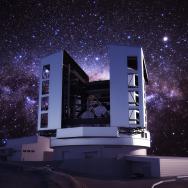The National Science Foundation has awarded $52.66 million to upgrade the Simons Observatory, a set of telescopes high in the Chilean desert that looks for traces of light from the earliest epochs of the universe.
A team led by the University of Pennsylvania, Princeton University and the University of Chicago will undertake a major infrastructure upgrade to the Simons Observatory, including doubling the scientific capabilities of the camera, solar panels to power the observatory in an environmentally sustainable manner, and support for a data analysis pipeline.
Located in the high Atacama Desert in northern Chile at an altitude of 5,200 meters, Simons Observatory provides scientists an unprecedented window into the nature of fundamental physical processes that have governed the origin and evolution of the universe since the dawn of time itself.
The observatory uses an array of four telescopes, which will have 100,000 detectors total, to detect the cosmic microwave background—light still traveling across the universe from the aftermath of the Big Bang.
Advanced Simons Observatory
The five-year project will result in the Advanced Simons Observatory. The upgrades will double the mapping speed of the main telescope—the six-meter Large Aperture Telescope receiver—and offer improvements to instrumentation, efficiency and sustainability, and community-focused data sharing.
After the upgrade is complete, the observatory will begin a five-year observing session (through 2033), which will produce a landmark large-scale survey of the sky with six-color imaging in the millimeter wavelength spectrum of light. This will enable precise measurements of a diverse set of phenomena: probing the dawn of the universe, what it looks like today, and tracking phenomena that are changing as astronomers watch, such as star flares or gamma-ray bursts.
“The NSF AWARD for the Advanced Simons Observatory will provide resources to make the Simons Observatory the most capable instrument studying the millimeter-wave sky for the coming decade,” said Mark Devlin, professor of astronomy and astrophysics at the University of Pennsylvania and the principal investigator for the project. “The results will have far-reaching impacts across multiple astronomical areas from our solar system, all the way to the beginning of the universe. I cannot imagine a more exciting area for discovery.”
The upgrade will allow scientists to improve our understanding of the very early universe, as well as myriad other phenomena.
Examining stellar flares, gamma ray bursts
This includes a new window into the time domain of the universe, which will help researchers examine events like stellar flares, gamma ray bursts, and tidal disruptions—instances of a star being “eaten” by a black hole.
In addition, the upgraded observatory will improve its magnetic field measurement, allowing scientists to better understand how stars are formed and allow for more sensitive mapping of how stars interact with their host galaxies, which will create a clearer picture of galaxy evolution.
“I am inspired to work on this project because it exists at the nexus of my two passions: ground-breaking instruments and the potential to discover new insights about the nature of our universe,” said Jeff McMahon, an associate professor of astronomy and astrophysics who is a co-investigator in the project. As Instrument Scientist, McMahon will lead a team to fabricate optics, tests receivers, carry out the integration of these new components on site in Chile, and ensure the instrument delivers the data needed.
On the sustainability front, the Advanced Simons Observatory will establish a new paradigm for green observatories at remote sites, replacing 70 percent of the power at the site with solar energy, which will save up to 2 million kilograms of CO2 emission per year and allow for more observation, with more sensitive results.
The newly upgraded observatory will also revolutionize how the worldwide astrophysics community will be able to access and interact with survey data. It will map the sky more than an order of magnitude faster than its predecessor the Atacama Cosmology Telescope, and provide analysis tools and training events to make legacy maps accessible to scientists around the globe.
At the University of Chicago, McMahon will lead a team to fabricate and test optics for the upgraded telescope. “This project will support a new generation of Chicago students to be at the forefront of cosmological measurements,” said McMahon.
Large-scale survey projects like those that will be undertaken at the Advanced Simons Observatory exemplify the ways in which researchers are harnessing big data to make groundbreaking discoveries. The public nature of survey data, and the collaborative atmosphere encouraged by such sharing, means that the Advanced Simons Observatory findings will go on to fuel student projects and papers, creating future leaders in the field.
“The Advanced Simons Observatory will provide insights into questions we have been asking for decades,” said McMahon. “I am extremely happy that the quality of the data, and the public data release, will enable broad communities of astronomers to answer questions we have not yet thought of and make discoveries in new research directions.”
